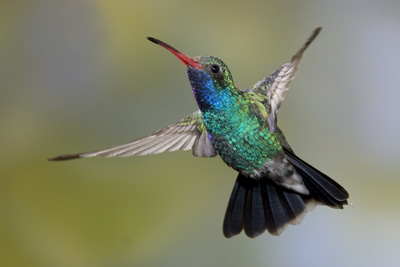
Trip Report:
Arizona Hummingbird Photo Shoots 2008

It seems we say this every year, 'The Best Ever,' as we review and remember the highlights from our 2008 Arizona High Speed Flash Hummingbird Shoots, and this year we'd have to once again say that is indeed the case. This year, I must first thank Bogen for their generous support in supplying us with extra Bogen Magic Arms, Articulating Arms, and Lightstands, which we used in a huge variety of different applications. I must also thank Bill Forbes, the inventor and distributor of the PhotoTrap and the owner of The Pond, for all of his help. Clay Wimberley, of Wimberley tripod heads, was also very supportive with Plamps and macro clamps we used for our hummingbird sets and our personal macro photography.
This year was exceptional in several ways. Foremost, of course, was the hummingbirds, which were perhaps the most active at each of the six shooting stations we provided as we've ever had. No set was truly slow, although some were certainly slower than others, but most importantly, all had some activity at each shooting session. The average 'hit' for one of our feeders is about every twenty minutes, based on doing five or six sets for the last twelve years or so, but by an average, of course, it means some sets are getting hits every two minutes or so, and others ... at least some years, just once an hour or so. This year, even our slowest set averaged about a hit every twenty minutes or so, and our best sets often averaged a hit every two minutes. With six different sets going this year, our participants had a huge variety of opportunities as they rotated through each of our six flash setups. Quite literally, some shooters went through 4 gb in just one session!
We always tell our participants how variable any given set can be, in that one week, or portion of a week, a particular set may be slow, perhaps even very slow, in comparison to the others, and participants often wonder why we even bother to maintain that set. Set One, behind our room, is a perfect example. While it was fairly active in the beginning of our time in Arizona, it eventually slowed down and by the second last week it seemed rather unproductive. Then, for the FIRST TIME in all of the years we've been doing this shoot, a male Broad-tailed Hummingbird found the feeder at Set One and began to hit it frequently. Eventually it went to other feeders as well, but Set One was its favorite. Magnificents, broad-billeds, and black-chinneds hit that feeder as well, and for our last session there were times when it was the most productive, in terms of species. So ... you just never know.
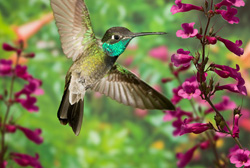

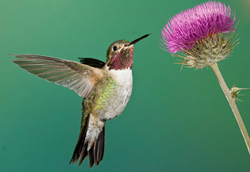
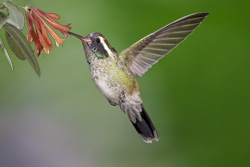
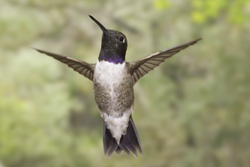
This year we had FIVE species that visited the feeders on a regular basis for at least one session (we held three different shoots this year). Those species included broad-billed; magnficent, black-chinned, broad-tailed, and the very rare white-eared. We also had a female Blue-throated for a short time, and we were frustrated by an Anna's and a Rufous hummingbird that patrolled the area but never got to our feeders.
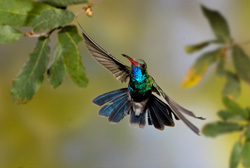 Each
of our six hummingbird sets were comprised of four electronic
flashes, with Bogen Magic Arms,
Articulating Arms, or Flex Arms supporting the flashes or the
tube feeders. Although we started with mixed systems that required
either a photographer using his own flash to set off our flashes
via slaves, or direct wiring, we eventually ended up in a system
that was a complete direct wiring system that required nothing
of the photographer other than his or her lens and camera! And,
at 1/4000th of a second or so, at an average aperture of f22,
photographers caught action and enjoyed great depth of field,
too.
Each
of our six hummingbird sets were comprised of four electronic
flashes, with Bogen Magic Arms,
Articulating Arms, or Flex Arms supporting the flashes or the
tube feeders. Although we started with mixed systems that required
either a photographer using his own flash to set off our flashes
via slaves, or direct wiring, we eventually ended up in a system
that was a complete direct wiring system that required nothing
of the photographer other than his or her lens and camera! And,
at 1/4000th of a second or so, at an average aperture of f22,
photographers caught action and enjoyed great depth of field,
too.
We also had our usual natural light setups, with both a water set and a dead tree forest, which was visited by a variety of song and perching birds, including Mexican jays, Acorn woodpeckers, Arizona woodpeckers, bridled titmice, white-breasted nuthatches, black-headed grosbeaks, lesser goldfinches, pine siskins, Scott's orioles, Oregon juncos, lark sparrows, Bewick's wrens, American robins, white-winged doves, and a few other species. Our water set wasn't used as often as it had been in the past, but I think the hummingbird shooting, and the Siren's Song of digital editting, kept folks from using the peak afternoon light for the water set.
One absolute highlight this year was the very tame flock of Wild Turkeys that visited our feeders nearly every day, providing great opportunities for head shots, details of plumage, and for those who pursued the turkeys more vigorously, super shots of the Tom turkeys displaying and strutting. In Pennsylvania, where we live, wild turkeys are wary, elusive, and virtually impossible to photograph -- at least I've not been successful, but every day we had a chance to shoot turkeys doing a variety of activities.
The hummingbird photography was great, but we're always gratified when folks cite The Pond as one of the unexpected highlights and thrills of their trip. Our friend Bill Forbes has a wonderful natural waterhole setup about 5 miles away as the hummer flies (about one half hour's drive, by car) where a variety of species normally not seen in Madera Canyon are filmed. Usually, shooters photograph at least 15 different species in their session at The Pond, and some often shoot 25 to 30 different species. Bill has two blinds erected by the waterhole, and an enormous amount of props that can be positioned as you like for different perspectives and views, and working distances, and The Pond is so good we include a morning session there for all of our shooters. This year's highlights at The Pond included numerous flocks of baby Gambel's Quail with their parents, an uncommon Western Tanager on an ocotillo, bathing Bullock's Orioles, and a hunting Cooper's hawk. Other species included curve-billed thrashers, lark sparrows, song sparrows, bronze cowbirds, brown-head cowbirds, Northern cardinals, pyrrhuloxias, phainopeplas, Lucy's warblers, Wilson's warblers, Roadrunners, Northern mockingbirds, house finches, black-headed grosbeaks, white-winged doves, mourning doves, Inca doves, and Yuma ground squirrels.
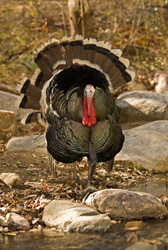
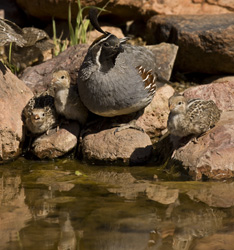
This year it was unusually cool and windy in southern Arizona, although a long-time resident of the area told me that this year's spring was normal, and the past ten years were unusually warm. If that is true, it might account for the fact that we had so many broad-tailed hummingbirds in the area, including a full adult male, one slightly immature male, and several females visiting our feeder for the first time. The previous owner of the lodge used to shoot plenty of broad-tailed hummers, ten or more years previously, when one might assume they were more common, and reflective of weather similar to that we had this year. It will be interesting to see if that trend continues next year.
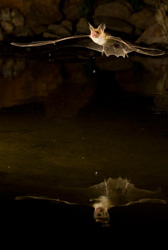 However,
the wind prevented me from experimenting with a new offering we'll
be adding next year, and that is an evening BAT shoot at The Pond.
Because of our schedule, and the wind -- which messes up reflections
and often coats the pond with dust, I only had one chance to shoot
the bats that normally visit The Pond nightly, skimming the water
surface for a drink. Bill uses his incredible PhotoTrapper equipment
to trigger the cameras and flashes, so all I had to do was guess
- with Bill's help -- where a bat would be after passing through
the beam and focus there. It's a crapshoot, in terms of how many
bats may pass by, and how accurately you're focused, and whether
or not a bat passes correctly through the frame, but if it works,
WOW! I only had a few passes the evening I tried, but I got four
neat shots that would have been impossible otherwise. We're going
to include the bat shoot as an option next year, and I suspect
it will be a very popular addition!
However,
the wind prevented me from experimenting with a new offering we'll
be adding next year, and that is an evening BAT shoot at The Pond.
Because of our schedule, and the wind -- which messes up reflections
and often coats the pond with dust, I only had one chance to shoot
the bats that normally visit The Pond nightly, skimming the water
surface for a drink. Bill uses his incredible PhotoTrapper equipment
to trigger the cameras and flashes, so all I had to do was guess
- with Bill's help -- where a bat would be after passing through
the beam and focus there. It's a crapshoot, in terms of how many
bats may pass by, and how accurately you're focused, and whether
or not a bat passes correctly through the frame, but if it works,
WOW! I only had a few passes the evening I tried, but I got four
neat shots that would have been impossible otherwise. We're going
to include the bat shoot as an option next year, and I suspect
it will be a very popular addition!
Pallid Bat, just having scooped up a drink,
caught with the PhotoTrap at The Pond. Catching a reflection,
and getting the bat in focus is a challenge -- but very rewarding
when one succeeds!
 Our waterset
had nightly visitors, and each night I'd set up a PHOTOTRAP
to attempt to capture portraits of various mammals that would
visit my man-made waterhole. I was successful on several occasions,
and captured great shots of ringtails (ringtailed cats, a distant
relative of the raccoon), gray fox - the first time I've shot
one in the wild!, striped and hooded skunks, and one opossum.
A black bear began appearing at some of the Canyon's lodges, including
our's, so I had to take down my equipment before I went to sleep
to be sure that the bear didn't visit my set and destroy my gear.
Had I been able to keep the setup going all night ... I can just
imagine what I would have been shooting. The setup required nearly
an hour's work each night as I arranged cameras and TTL flashes
to light up the area, and set the PhotoTrap beam to capture these
nightly visitors. Great fun, and a lot of work. I'm thinking of
adding this to our offering for next year, but I'm a bit hesitant
since the shooters would need to stay up to retrieve their gear
at 'closing' time, and would need one of Bill's releases to fire
their camera. I'll say more about this in this month's Question
of the Month.
Our waterset
had nightly visitors, and each night I'd set up a PHOTOTRAP
to attempt to capture portraits of various mammals that would
visit my man-made waterhole. I was successful on several occasions,
and captured great shots of ringtails (ringtailed cats, a distant
relative of the raccoon), gray fox - the first time I've shot
one in the wild!, striped and hooded skunks, and one opossum.
A black bear began appearing at some of the Canyon's lodges, including
our's, so I had to take down my equipment before I went to sleep
to be sure that the bear didn't visit my set and destroy my gear.
Had I been able to keep the setup going all night ... I can just
imagine what I would have been shooting. The setup required nearly
an hour's work each night as I arranged cameras and TTL flashes
to light up the area, and set the PhotoTrap beam to capture these
nightly visitors. Great fun, and a lot of work. I'm thinking of
adding this to our offering for next year, but I'm a bit hesitant
since the shooters would need to stay up to retrieve their gear
at 'closing' time, and would need one of Bill's releases to fire
their camera. I'll say more about this in this month's Question
of the Month.

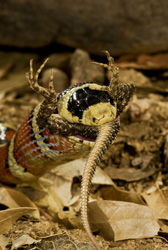
Each year, I buy an Arizona hunting license, which allows me to catch snakes or lizards for photography. Because of the coolness of this spring I wasn't very successful, but during our last hummingbird shoot I got lucky and rescued a very cooperative Western Diamondback Rattlesnake off of the road,within one hundred yards of the elementary school at the bottom of the Madera Canyon road! Most snakes we see, unfortunately, our road-kills, undoubtedly squished by cars intentionally, and I'm sure this rattler, so near the school, would have been smashed had I not seen it first. At any rate, our last hummer group finally had a chance to film a rattlesnake, and this one performed wonderfully, coiling into a wonderful S-shaped striking posture and holding that pose for an incredibly long time. It was a thrill for everyone, it was perfectly safe, and it was a neat highlight for the trip.
 All
told, I carried over 60 electronic flashes to Arizona for
this shoot, and employed 24 of these for our six hummer setups.
I also used four more for a PhotoTrap setup I did outside my room
for hummers -- this unmanned shooting is sure fun!, and another
four for a personal project or quest I've had for filming the
Arizona woodpecker. This year we had a pair that were incredibly
tame and would visit our suet log right outside our room. Usually
they'd announce their arrival by a loud tweak, similar to the
call of a downy or hairy woodpecker, and if I heard it, I'd drop
whatever I was doing (if I could) and I'd plug in the flashes
and man a camera I kept positioned for this purpose. I don't know
if I've got my definitive shot yet, but I'm sure closer than I'd
been! I also used five 550 TTL flashes for the waterset for my
night-time use, using Bogen Lightstands to support the flashes,
and Bogen Magic Arms to lock my tripods securely in place in case
a bear wandered by unexpectedly early. The Magic Arms would then
prevent the tripods from tipping over if bumped, although nothing
would save the gear if a bear decided to climb OVER the equipment
to get to the water, which is why I had to take the set down every
night.
All
told, I carried over 60 electronic flashes to Arizona for
this shoot, and employed 24 of these for our six hummer setups.
I also used four more for a PhotoTrap setup I did outside my room
for hummers -- this unmanned shooting is sure fun!, and another
four for a personal project or quest I've had for filming the
Arizona woodpecker. This year we had a pair that were incredibly
tame and would visit our suet log right outside our room. Usually
they'd announce their arrival by a loud tweak, similar to the
call of a downy or hairy woodpecker, and if I heard it, I'd drop
whatever I was doing (if I could) and I'd plug in the flashes
and man a camera I kept positioned for this purpose. I don't know
if I've got my definitive shot yet, but I'm sure closer than I'd
been! I also used five 550 TTL flashes for the waterset for my
night-time use, using Bogen Lightstands to support the flashes,
and Bogen Magic Arms to lock my tripods securely in place in case
a bear wandered by unexpectedly early. The Magic Arms would then
prevent the tripods from tipping over if bumped, although nothing
would save the gear if a bear decided to climb OVER the equipment
to get to the water, which is why I had to take the set down every
night.
Last, one of the highlights virtually every group cited was Mary's gourmet cooking, where she supplied every lunch, and three full four course dinners during each shoot. How she does this in the tiny kitchens these cabins have, and how see does so using two different kitchens in two rooms at the same time, is a marvel both to me and to the participants. Far more work than I'd like to see her do - on days where she does lunch and dinner she begins by 10AM and finishes by 10PM, with maybe, maybe a break between 2 and 4, if she's lucky.
Finally, this report wouldn't be complete without extending thanks to the new owners of the Santa Rita Lodge, where we stay, for all of their help and cooperation, and especially to their new site manager, Tom, who was a wonderful help whenver we needed some assistance. Why do we spend so much time here in Southern Arizona? See our Bonus Question of the Month for the answer -- if this report doesn't say it all!
If you'd like to see our other years' various Trip Reports, and photos that help to illustrate the story, check out the Home Page and the reports listed there, or click on any of these links: